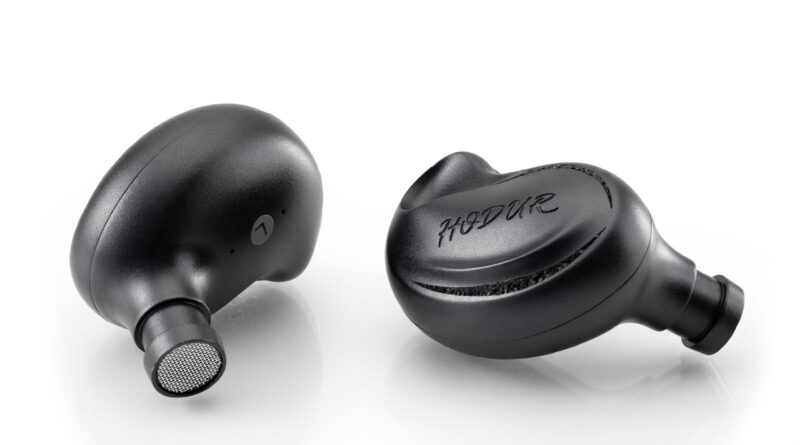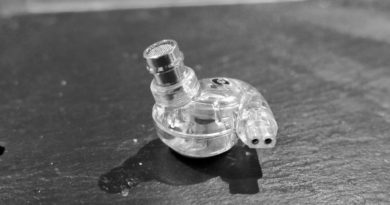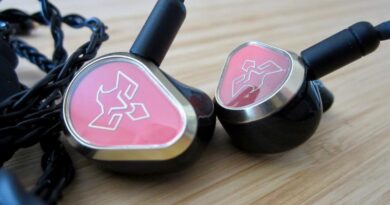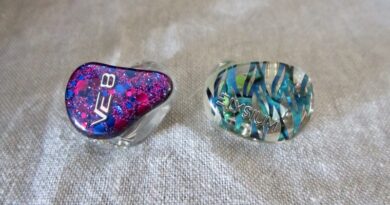Kinera Hodur Review – Treble And More
In this article we discuss one of the most recent models by Kinera: the Hodur. Featuring a triple tech driver configuration, these seem interesting also in view of the not too modest asking price of $299. Here are my audition notes presented in my usual schematic format.
In this Article
At-a-glance Card
| PROs | CONs |
| Energetic presentation delivering listening pleasure. | Timbre incoherence amongst the drivers. |
| Nice treble. | Sub-bass needs more control. |
| Good treble detail retrieval. | Lean notes, especially mids and highmids. |
| Very good fit, very comfortable to wear (for me). | Sibilant female vocals. |
| Nice bundled accessories. | Fuzzy imaging, poor instrument separation. |
| Expensive vs similar or better hybrid competition. |
Full Device Card
Test setup
Sources: Questyle QP1R / Sony NW-A55 mrWalkman / Questyle M15 / Questyle CMA-400i – Final E tips – Stock cable – lossless 16-24/44.1-192 FLAC and DSD64/128 tracks.
Signature analysis
Tonality
Hodur’s presentation is an evident W-shape, reaching good result in terms of tonal balancing however lacking in terms of timbre coherence and overall organicity. Bass is rather flowery, treble is by converse dry and technical, and such two souls don’t merge one into another as smoothly as they should (and I would prefer).
The general timbre is somewhat lean accross the board, with a partial exception represented by the sub bass – which also contributes to the mentioned incoherency feeling. Mid bass helps warming the presentation up, without adding too much butter to the notes however.
Sub-Bass
Sub bass is well extended and present. The rumble often gets an excessive bit out of control up to sounding bloaty, and interfering with the midbass’ job.
Mid Bass
Hodur’s midbass is… uncommon. I can describe it as strong, warming also insofar as not particularly fast, although not sloppy at all, either. Which would all be good if it were not for a moderate artificial timbre making it lack realism.
In more vulgar terms Hodur’s bass overall (sub+mid) is quite deep, energetic and colored, and as such I find it more pleasant when listening to some genres (electronic, rock…) and less ideal on others (acoustic music in general, jazz, classical…)
Mids
Mids are where Hodur’s overall lean timbre deepens its roots. Their tuning is quite brave in a sense, especially for the higher half of the mids segment which is forward, energetic and somewhat bright while succeeding in staying south of shouty – although sometimes by a tiny margin. Note weight is lacking everywhere, which is a pity as this results in missing organicity especially on acoustic music.
Male Vocals
Male voices like the rest of the lower part of the mid segment are more recessed than the rest. Add some note thinness and you easily look elsewhere if you’re fond of tenor vocals.
Female Vocals
Female vocals are much better than male on Hodur, insofar as much more forward, brighter, cleaner and more energetic. The downside is they come very close to shoutyness some times, and sadly they do pass the sibilance threshold in a few occasions too many, and they lack the body it takes to make them convincingly natural/organic.
Highs
Treble is no doubt “the” strong point on Hodur, with particular regards to its EST driver performance, which kicks in just above highmids, by ear I’d say around 3.5/4K onwards. Highmids’ already fast, BA-style transients become supersnappy thanks to the well tuned EST, never scanting into artificial metallic or “electrical” timbre. Good job here!
Without prejudice to what noted before about horizontal tonal incoherence, here’s where the re-balancing role played by the bass reveals itself as so precious in the overall Hodur presentation, which would certainly come across as “overly trebly” otherwise. Indeed, within its noted limitations the ensemble taken as a whole is indeed pleasant, I reckon especially for “treble heads” longing for “not-just-bright” IEMs.
Technicalities
Soundstage
Hodur draw a modestly wide and high stage, however depth is above average – provided of course a good DAC is upstream, needles to say (or is it?).
Imaging
Hodur’s imaging is no better than average, and that’s already a compensated evaluation resulting from a bit better performance on less crowded passages, and definitely fuzzy rendering on more crowded ones.
Details
Hodur’s EST driver is very good at detail retrieval within of course its applicative scope (treble frequencies). Not the same happens on mid frequencies, where details are at best average due to lean note body, and especially on the bass, where texture is quite basic and an over-flowerly (so to call it) rumble tends to often fog the segment off.
Instrument separation
Even more than imaging, Hodur lack big time on instrument separation. Everything is made difficult by the lack of microdynamics coming off the BA and the EST drivers, negatively paired with sub bass’s “rumble dust” covering the lower registers too often.
Driveability
While not particularly hard to drive in terms of sound volume Hodur are very tricky to bias as their DD is very sensible to dampening, and their 8 ohm impedance calls for quite specific sources – or the midbass gets immediately bumped up which, coupled with the already “egocentric” subbass, makes up for a sort of “indistinct blob” down there, which is certainly not pleasant to hear.
In addition to impedance, beware warm sources mainly as they negatively resonate with Hodur’s difficulties on instrument separation.
Physicals
Build
It’s of course totally subjective but I find Hodur’s “kidney” shape very nice both in terms of ergonomics and aesthetics. I could instead easily do without the thin line of sparkling little stones added as a decoration on the backplate. The aluminum structure comes across as convincingly solid.
Fit
Nozzles are not particularly long so the fit stays on a somewhat shallow level. In my particular case a 1-size-larger than normal eartip on the left channel helps getting the right fit.
Comfort
Very comfy once properly fit thanks to the modest sized, oval shaped and smoothed housings. Surely amongst the most comfortable IEMs I ever used.
Isolation
Passive isolation is quite average, and depends on how you sit the housings into the concha so each one’s experience will be a bit different.
Cable
Hodur are supplied with a nice hybrid material (silver plate copper + pure copper) stock cable bearing modular termination plugs. Oddly enough, only 3.5 and 4.4mm terminations are included in the bundle, no 2.5 plug – a pity.
The modular system does not come with a click-lock mechanism to secure the plug in place, which makes me suspect that terminal plugs may tend to become a bit lose over time. This is however a speculation, as I used the Hodur for a few weeks and those have definitely not produced any form of deterioration on the system.
Specifications (declared)
| Housing | CNC 5-axis Carved Aviation Aluminum Alloy Shell |
| Driver(s) | Kinera High Sensitivity & Low Power Electrostatic Driver + Kinera Customized K10012 BA Driver + 10mm Coaxial Dual-magnetic Tesla Composite Diaphragm Dynamic Driver |
| Connector | 2pin 0.78mm |
| Cable | 1.2m 8 cores silver plated copper + OCC mixed cable, with modular plug system. Single ended 3.5 and balanced ended 4.4 termination included. |
| Sensitivity | 106 dB/mW |
| Impedance | 8 Ω |
| Frequency Range | 5–40.000 Hz. |
| Package and accessories | 5 pairs of Final-E black tips (S MS M ML L), 3 pairs of K07 tips (S M L), 4 pairs of K-285-02 tips (SS S M L), cleaning brush, sturdy genuine leather carry case, modular plug cable with 3.5 and 4.4 termination modules. |
| MSRP at this post time | $ 299 |
| Product Page | Kinera Audio Official |
Miscellaneous notes
Hodur are one of those few IEMs I encountered for which even a short “burn-in” did make for a very obvious improvement. Out of the box the bass was totally unaudible (fully bloated) and the entire presentation was obscure, compressed. Just a couple of short auditions later, it all settled to what I tried to describe here above.
Hodur are supplied with a very, very good bundle of eartips: a full 5-sizes set of Final Type-E (black), a 3-sizes set of Kinera K07 tips (very, very similar – read identical – to Kbear A07), and a 4-sizes set of Kinera K-205-02. In particular, I found it difficult to decide which between Type-E and K07 pair better on the Hodur. In the end I probably prefer K07 as they tend to “tame” the sub-bass bloat a bit.
The carton box… Well this is an odd one. Of course it has nothing to do with sound. It however caught me (in positive) for how creative, well-designed, and well realised it appeared when I unpacked it.
I mean it: it’s a box which is clearly trying to communicate with me, being European, both in terms of historical evocation, colour and shape selections, internal setup, storytelling… everything. Very well conceived. Immediately afterwards, however, I was stunned when I noticed with which incredible lack of accuracy the copywrite has been developed for the box and the literature inside it.
Grammaical errors, typos, wrong translations, symplistic lexical forms. Even 2 out of 3 syllabic splittings are ridiculously wrong (this stuff is taught at primary school). Horrible. Seems as if Kinera paid a good level, international-cultured professional marketeer for the general brand design and graphic concept, but didnt put any attention in hiring someone knowing English at a decent level.
A glowing example of how even a single amateur-level contributor can waste the otherwise very good work carried out by other good professionals. Ah, well…
Comparisons
Geek World GK10 ($48)
GK10 feature 2 DD, 1 BA, 2 Piezo drivers, and a price which is 1/6 then Hodur’s
GK10 have more limited sub bass extension so they generate less rumble then Hodur. Mid bass on GK10 is also lower in accentuation compared to Hodur, and at times it appears like a bit “dampened” (for lack of a more appropriate word).
That said however, sub and mid bass are more organic on GK10 and they don’t interfere with the rest of the segments. Mids are more recessed on GK10 but also less lean compared to Hodur, so globally more pleasant.
No female voice sibilance on GK10 unlike Hodur. Trebles are somewhat similar, with Hodur having it this time as the “Piezo-timbre” comes out more prominent and more often on GK10 vs how nicely “discrete” the EST nature of the driver is on Hodur. Detail retrieval is better on Hodur’s trebles, equivalently modest on mids on both models, and much better on GK10’s bass.
Both GK10 and Hodur suffer from timbre incoherence issues, Hodur being the worst of the two due to more invasive bass. Unlike Hodur, GK10 offer very precise imaging and nothing short of surprising layering (especially considering its ridiculous price). Stage drawing is different: taller for GK10, deeper for Hodur, both limited horizontally.
Both are tricky to bias due to identical ultralow impedance (8 ohm). Hodur is more comfortable to wear.
BQEYZ Summer ($129)
Summer feature 1 DD, 1 BA, 1 Piezo ceramic driver at less then half Hodur’s price.
Summer have less important mid-bass, and a sub-bass which is similar in quantity to Hodur’s, but is not bloaty so won’t steal the scene. Mids and vocals are quite similar on the two models, in both cases too lean to sound organic, nontheless decent overall. Highmids are better on Hodur, except for the sibilance.
Trebles are very similar, with Hodur having the edge in terms of quality and timbre, Summer’s piezo nature coming out more evident in comparison. Detail retrieval is better on Hodur’s trebles, similar on either’s mids, and better on Summer’s bass.
Summer images much better than Hodur, although with a sharp preference for horizontal distribution / stereo effect. Layering is obviously better on Summer. Stage is wider on Summer, way deeper on Hodur. S
ummer is much easier to properly bias thanks to its 32 ohm impedance and good sensitivity. Summer is more capricious in terms of eartips selection, and a bit less comfortable than Hodur to wear.
Shuoer Tape ($116)
Tape feature 1 DD, 1 Electret Tweeter for little more than one third of Hodur’s price.
Tape’s sub and mid bass are monumentally better than Hodur in terms of elevation, cleanness, power, texture… everything. Different from Hodur’s W-shape, Tape feature an obvious V-shape presentation resulting in mids being recessed in addition to lean (in that, quite similar to Hodur’s).
Female vocals scant into sibilance on Tape as well. Trebles are extremely good on Tape, and it’s a really tight call on deciding which is better compared to Hodur – I’d probably settle for a tie, considering that Tape offer a tad more body which I like better, but they feature a 16KHz peak which may be nasty for some, and calls for some EQ correction in most cases.
Detail retrieval is similar high quality on either model’s trebles, and is hands down better on Tape for the bass segment.
Imaging and layering are much better on Tape, easy enough for how lacking they are on Hodur. Stage is almost holographic on Tape, which are also much easier to drive then Hodur. Tape are extremely – or I should probably say infuriatingly – capricious as for tips selection, and depending on ear shape they may be not comfortable at all to wear.
Intime Miyabi ($145 + import costs)
Miyabi feature 1 DD, 1 Piezo ceramic tweeter for little more than half Hodur’s price.
Sub bass is less prominent on Miyabi then on Hodur, and never bloaty let alone invasive. Mid bass has similar elevation on Miyabi and Hodur, however quality wise it is very obviously better on Miyabi in terms of precision, slam, texture, detail and organicity.
Mids are more recessed on Miyabi however they are much more organic compared to Hodur. Vocals are much better on Miyabi, tenors are absolutely organic, realistic, and contraltos and sopranos are bodied and even flutey at times.
Trebles is where both models express some of their magic and it’s a tight call to say which is better but I would give the palm to Miyabi in this case: superthin detail comes out a bit better on Hodur but this in my books superseded by Miyabi piezo’s “typical timbre” virtually disappearing, diluted in a well bodied, natural, realistic, transparent treble tone coming off that driver. Miyabi retrieve way more and better defined details from bass and mids.
Imaging and especially layering / separation is where Miyabi excel and are worth a few times their prices so the comparison with the very modest (in this area) Hodur is just… embarassing. Stage is better on Miyabi horizontally and vertically, while the two models are similar in terms of depth.
Both models are very easy to fit and comfortable to wear. Miyabi require some more amping power than Hodur, but are much less tricky to dampen thanks to a much more “urban” impedance (22 ohm).
Conclusions
These Hodur deliver a definitely pleasant overall presentation, featuring energetic, engaging musicality with a particular accent on treble definition and detail, and a solid deep bass counterbalancing the tonality on the opposite end.
They are also amongst the most comfortable UIEMs I ever worn – this is also worth noting. On the down side I hear a non-organic timbre making them hardly fit for acoustic music, timbre incoherence and fuzzy instrument separation.
The sample has been provided free of charge courtesy of Kinera staff, which we thank once again for the testing opportunity.
Our generic standard disclaimer.







